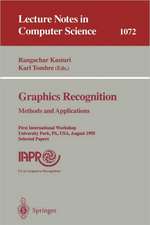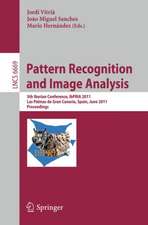Computational Pulse Signal Analysis
Autor David Zhang, Wangmeng Zuo, Peng Wangen Limba Engleză Hardback – 6 oct 2018
| Toate formatele și edițiile | Preț | Express |
|---|---|---|
| Paperback (1) | 647.79 lei 43-57 zile | |
| Springer Nature Singapore – 15 ian 2019 | 647.79 lei 43-57 zile | |
| Hardback (1) | 654.21 lei 43-57 zile | |
| Springer Nature Singapore – 6 oct 2018 | 654.21 lei 43-57 zile |
Preț: 654.21 lei
Preț vechi: 817.77 lei
-20% Nou
Puncte Express: 981
Preț estimativ în valută:
125.22€ • 136.07$ • 105.26£
125.22€ • 136.07$ • 105.26£
Carte tipărită la comandă
Livrare economică 21 aprilie-05 mai
Preluare comenzi: 021 569.72.76
Specificații
ISBN-13: 9789811040436
ISBN-10: 9811040435
Pagini: 339
Ilustrații: XIV, 328 p. 154 illus., 110 illus. in color.
Dimensiuni: 155 x 235 mm
Greutate: 0.66 kg
Ediția:1st ed. 2018
Editura: Springer Nature Singapore
Colecția Springer
Locul publicării:Singapore, Singapore
ISBN-10: 9811040435
Pagini: 339
Ilustrații: XIV, 328 p. 154 illus., 110 illus. in color.
Dimensiuni: 155 x 235 mm
Greutate: 0.66 kg
Ediția:1st ed. 2018
Editura: Springer Nature Singapore
Colecția Springer
Locul publicării:Singapore, Singapore
Cuprins
1. Introduction: Computational Pulse Diagnosis.- 2. Compound Pressure Signal Acquisition.- 3. Pulse Signal Acquisition Using Multi-Sensors.- 4. Baseline Wander Correction in Pulse Waveforms Using Wavelet-Based Cascaded Adaptive Filter.- 5. Detection of Saturation And Artifact.- 6. Optimized Preprocessing Framework for Wrist Pulse Analysis.- 7. Arrhythmic Pulses Detection.- 8. Spatial and Spectrum Feature Extraction.- 9. Generalized Feature Extraction for Wrist Pulse Analysis: from 1-D Time Series to 2-D Matrix.- 10. Characterization of Inter-Cycle Variations for Wrist Pulse Diagnosis.- 11. Edit Distance for Pulse Diagnosis.- 12. Modified Gaussian Models and Fuzzy C-Means.- 13. Modified Auto-Regressive Models.- 14. Combination of Heterogeneous Features for Wrist Pulse Blood Flow Signal Diagnosis via Multiple Kernel Learning.- 15. Comparison of Three Different Types of Wrist Pulse Signals.- 16. Comparison Between Pulse And Ecg.- 17. Disscusion and Future Work.
Notă biografică
David Zhang graduated in Computer Science from Peking University. He received his MSc and PhD degrees in Computer Science and Engineering from the Harbin Institute of Technology (HIT) in 1982 and 1985 respectively. From 1986 to 1988 he was a postdoctoral fellow at Tsinghua University and then an associate professor at the Institute of Automation, Chinese Academy of Sciences, Beijing. In 1994 he received his second PhD degree in Electrical and Computer Engineering from the University of Waterloo, Ontario, Canada. Currently, he is a chair professor at the Hong Kong Polytechnic University, where he is the founding director of the Biometrics Research Centre (UGC/CRC), which has been supported by the Hong Kong SAR Government since 1998. He also serves as visiting chair professor at Tsinghua University and HIT, and adjunct professor at Shanghai Jiao Tong University, Peking University, National University of Defense Technology, and University of Waterloo. He has published more than 15books and 400 international journal papers. He was listed as a highly cited researcher in engineering by Thomson Reuters in 2014, 2015 and 2016. Prof. Zhang is a Croucher senior research fellow, distinguished speaker of the IEEE computer society, and a fellow of both the IEEE and the IAPR.
Wangmeng Zuo is currently a professor at the School of Computer Science and Technology, Harbin Institute of Technology, Harbin, China. His research interests include discriminative learning, deep learning, image modeling and low-level vision, and biometrics. Dr. Zuo has published more than 50 papers in leading academic journals and at top-tier conferences. Dr. Zuo is an associate editor of the IET Biometrics, guest editor of Neurocomputing, Pattern Recognition, IEEE Transactions on Circuits and Systems for Video Technology, and IEEE Transactions on Neural Networks and Learning Systems. He has co-authored a book on medical biometrics and another book on biometrics. He is asenior member of IEEE.
Peng Wang is currently a lecturer at the School of Science, Northeast Agricultural University, Harbin, China. He received his B.S. degree in Information and Computing Science from Harbin Normal University, Harbin, China, in 2007, and the M.S. degree in Computer Science from the Harbin Institute of Technology, Harbin in 2009. From September 2009 to December 2009, he was a research assistant at the Department of Computing, Hong Kong Polytechnic University. His research interests include computerized medical diagnosis, pattern recognition, machine learning, and biometrics. Dr. Wang has published more than 20 papers in leading academic journals and conferences.
Textul de pe ultima copertă
This book describes the latest advances in pulse signal analysis and their applications in classification and diagnosis. First, it provides a comprehensive introduction to useful techniques for pulse signal acquisition based on different kinds of pulse sensors together with the optimized acquisition scheme. It then presents a number of preprocessing and feature extraction methods, as well as case studies of the classification methods used. Lastly it discusses some promising directions for the future study and clinical applications of pulse signal analysis. The book is a valuable resource for researchers, professionals and postgraduate students working in the field of pulse diagnosis, signal processing, pattern recognition and biometrics. It is also useful for those involved in interdisciplinary research.
Caracteristici
The first systematic and comprehensive book on computational pulse signal analysis and its medical applications Covers all aspects of pulse signal analysis, including acquisition, preprocessing, feature extraction, classification and typical applications Provides an interdisciplinary reference for researchers and professionals in computer science and medical research





























